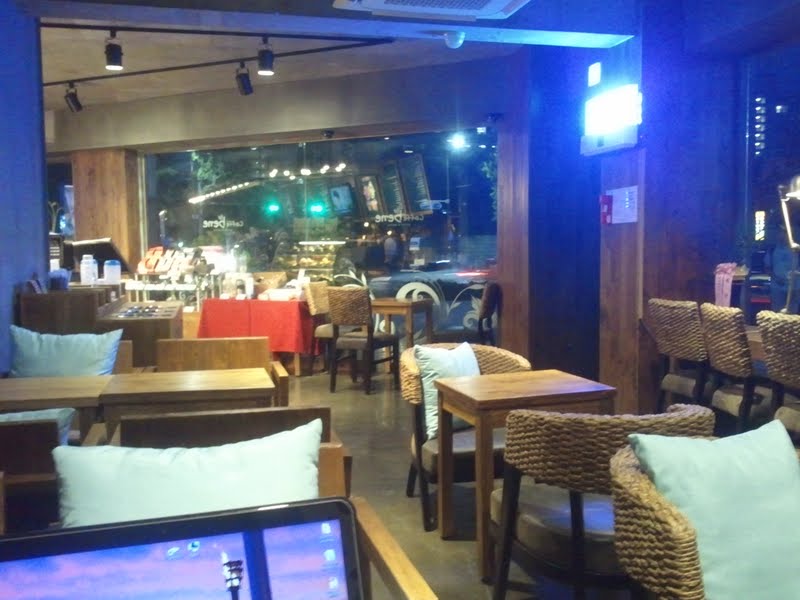People often go to cafe not for coffee but for work. According to Mehta, Zhu, and Cheema (2012), an appropriate ambient noise (e.g., cafe noise) enhances work performance. Their five studies showed that people performed creative tasks better when surrounded by the moderate ambient noise (70db) than the low one (50db) or the high one (85db). They argue that when people are surrounded by the moderate ambient noise, people cannot process information easily and thus they focus on their work harder and think more abstractly and creatively.
One website picked up their findings and enables its visitors to play a pre-recorded coffee shop noise at your computer (Coffitivity).


Many other space attributes beyond sound are discussed on how to create the ideal workspace. According to the Psyblog run by Jeremy Dean, for instance, there are six tips to do so: (1) avoid open-plan, (2) the great tidy-messy debate, (3) curvy is beautiful, (4) room with a (picture of a) view, (5) plants, and (6) decorates. When it comes to coffee shop chains, Starbucks seem to meet many tips while other competing Canadian coffee shop chains such as Second Cup or Tim Hortons seem to meet only few.
However, more space attributes (in a coffee place) will affect work performance. Two example attributes are whether a coffee place is indoor or outdoor and whether it is brand-new or run-down. Interestingly, most local coffee shops in Seoul are indoors and brand-new while many local coffee shops in North American cities are outdoors and relatively run-down. Since I generally worked more productively when I was at the local coffee shops in North America than when I was at those in Seoul, I expect [outdoor] and [run-down] might be extra critical attributes for a coffee shop to be an ideal workplace.



People often go to café not for coffee but for work. According to Mehta,Zhu,and Cheema (2012), an appropriate ambient noise enhances work performance. Therefore, when people surrounded by the moderate ambient noise, they tend to require more focus, allowing them to think more abstractly and creatively. In addition to many other space attributes beyond sound are discussed on how to create the ideal workspace. According to the blog run by Jeremy Dean, for instance, there are six tips to do so: (1) avoid open-plan, (2) the great tidy-messy debate, (3) curvy is beautiful, (4) room with a (picture of a) view, (5) plants, and (6) decorates. However, the writer argues more space attributes (in a coffee place) will affect work performance. Two example attributes are whether a coffee place is indoor or outdoor and whether it is brand-new or run-down. He cites his experience of being more productive in North American coffee shops with an ‘outdoor – run down’ ambiance compared to the ‘indoor -brand new’ ones in Seoul.
My opinion:
I deeply resonate with this post. In Korea, there are commercial facilities like Study room and Study café designed to enhance work performance. I also have personally experienced the significance of space attributes while utilizing these places. Based on this experience, I not only empathize with the post but also aim to analyze the reasons behind the decline of study rooms and the rise of study cafes in my town through a comparison of the respective space attributes.
The study room, as the origin of the facilities, has the following characteristics. This space is mainly visited by people studying for exams, focusing for long periods. They sell long-term tickets with fixed seats, creating a secluded atmosphere with numerous divided tables. Moreover, it offers an environment focused solely on studying rather than interior design.
In contrast, study cafes, relatively recent spaces, have the following characteristics. It combines the features of a study room and a cafe, attracting people who come for assignments or light studying. Additionally, they sell time-based subscriptions along with long-term tickets and provide an environment with an open structure and a relaxed atmosphere in interior design.
Based on the analysis of space attributes comparing these differences between the study room (TOZ) and the study cafe (A.round study cafe), I have summarized the reasons behind the decline of study rooms and the rise of study cafes as follows.
1. Serious and Intensive vs. Light and Casual
People instinctively feel a sense of pressure when it comes to work or studying. Therefore, when thinking about it, they tend to prefer study cafes that provide a lighter and less burdensome atmosphere. This preference extends to the pricing aspect as well. TOZ primarily offers expensive long-term tickets ranging from tens of thousands to hundreds of thousands of won. In contrast, A.round study café mainly offers time-based tickets in the range of a few thousand won. Moreover, both spaces provide a 4-hour tickets, but TOZ charges 6,500 won, while A.round charges 5,000 won, highlighting a significant difference in the hourly cost. As a result, users who initially used study rooms (TOZ) no longer frequented study rooms due to the emergence of study cafes (A.round), offering a better customer experience. This can be explained through the behavioral economics theory of ‘Prospect theory.’
2. Overwhelming vs Relaxed
The closed structure of study rooms, with independently arranged desks, gives users an overwhelming feeling of being focused. In contrast, the open layout of study cafes, where other users, backgrounds, and structures come into peripheral view, provides a relaxed atmosphere. TOZ primarily employs opaque partitions, dark-colored walls and floors, and concrete materials. A.round, on the other hand, uses translucent glass walls for spatial separation, bright-colored walls and ceilings, and wooden materials. Additionally, A.round adopts a nature-friendly ‘planterior’ concept using plants, one of the mentioned space attributes in the post. As a combined space of a cafe and a study room, A.round offers premium coffee, various snacks, and a space with massage chairs for a brief rest. Users, having experienced such ‘curated experiences,’ find it challenging to revert to the mediocre experiences offered by the traditional setting (TOZ).